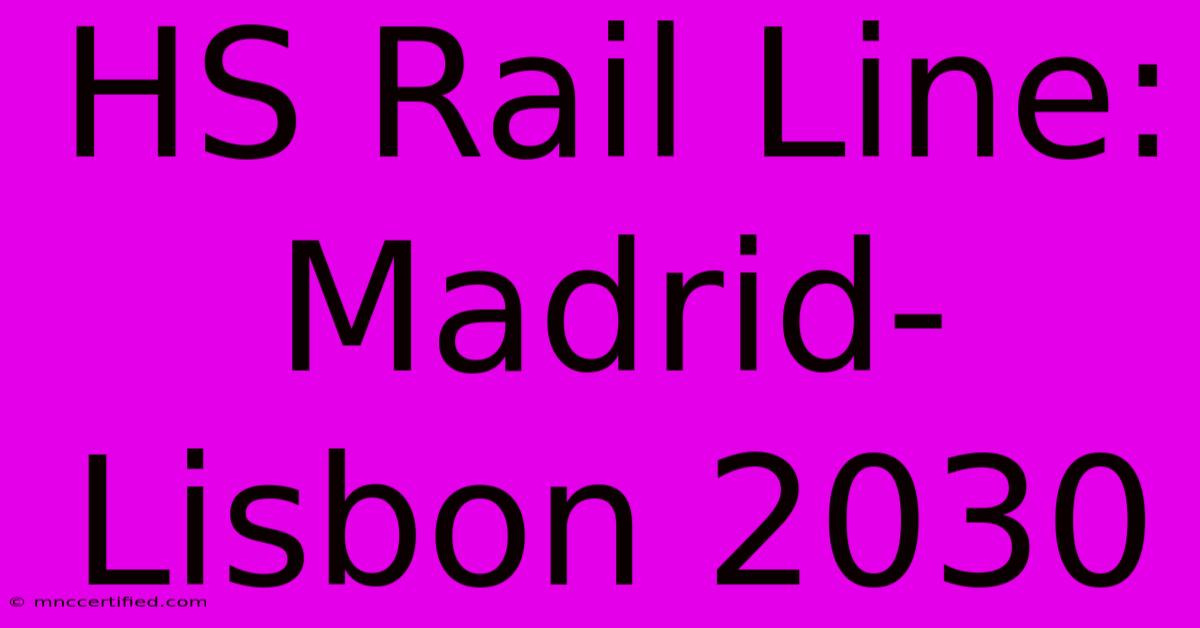HS Rail Line: Madrid-Lisbon 2030

Table of Contents
HS Rail Line: Madrid-Lisbon High-Speed Rail by 2030 - A Vision Taking Shape
The proposed high-speed rail line connecting Madrid and Lisbon by 2030 represents a significant infrastructural undertaking with the potential to revolutionize travel and boost economic growth across the Iberian Peninsula. This ambitious project, however, faces numerous challenges, from funding and political hurdles to environmental concerns and logistical complexities. Let's delve into the details, exploring the project's current status, anticipated benefits, and the obstacles that lie ahead.
The Madrid-Lisbon High-Speed Rail: A Timeline and Current Status
While a firm completion date of 2030 remains aspirational, significant progress has been made. The project has moved beyond the initial planning stages, with various feasibility studies completed and sections of the line already under construction or in advanced planning phases. Key milestones include securing funding from both the Spanish and Portuguese governments, as well as from the European Union. The exact timeline remains fluid, subject to various factors, including securing all necessary permits and overcoming potential unforeseen engineering challenges. Regular updates are crucial for stakeholders to monitor progress and potential delays.
Key Players and Stakeholders: Who's Involved?
The success of the Madrid-Lisbon HS Rail hinges on the collaborative efforts of multiple stakeholders. These include:
- Spanish and Portuguese Governments: These are the primary driving forces behind the project, responsible for securing funding, managing permits, and overseeing construction.
- RENFE and CP: The Spanish and Portuguese national railway companies, respectively, will play crucial roles in the operation and maintenance of the high-speed line.
- European Union: EU funding is essential for the project's financial viability, requiring adherence to EU regulations and environmental standards.
- Private Sector Investors: Private companies may be involved in different aspects, such as construction, technology provision, and potentially even operational management.
- Local Communities: The impact on local communities along the rail line, particularly regarding land acquisition and potential environmental disruption, must be carefully managed.
Anticipated Benefits of the Madrid-Lisbon High-Speed Rail
The successful completion of the Madrid-Lisbon high-speed rail line promises numerous benefits across various sectors:
Economic Advantages:
- Increased Tourism: Faster travel times will attract more tourists to both Spain and Portugal, boosting the economies of the regions along the route.
- Enhanced Trade and Commerce: Efficient freight transport will improve trade links between businesses in both countries, facilitating economic growth.
- Job Creation: The project itself will generate numerous jobs during the construction phase, and operation of the line will create further employment opportunities.
- Regional Development: Improved connectivity will stimulate economic development in less-accessible regions along the planned route.
Societal Benefits:
- Reduced Travel Times: The most significant benefit will be drastically reduced journey times between Madrid and Lisbon, fostering stronger social and cultural ties.
- Improved Accessibility: The high-speed rail will improve accessibility to both cities and smaller towns along the route, benefiting residents and visitors alike.
- Environmental Considerations (Potential): While construction will have an environmental footprint, the high-speed rail potentially offers a more sustainable mode of transport compared to air travel, reducing carbon emissions in the long run. (This requires thorough environmental impact mitigation).
Challenges and Obstacles: Navigating the Path to Completion
Despite its promising potential, the Madrid-Lisbon HS Rail project faces several challenges:
- Funding: Securing sufficient and consistent funding from multiple sources remains a crucial ongoing challenge.
- Political Will: Maintaining political consensus and consistent support across different governments throughout the lengthy construction period is vital.
- Environmental Concerns: Minimizing the environmental impact of construction and operation, addressing concerns related to land acquisition, and habitat disruption is critical.
- Technical Challenges: Overcoming potential engineering hurdles, such as complex terrain and geological conditions, will require innovative solutions.
- Regulatory Hurdles: Navigating bureaucratic processes and obtaining all necessary permits can cause significant delays.
Conclusion: A Transformative Project for the Iberian Peninsula
The Madrid-Lisbon high-speed rail line, if successfully completed, holds the potential to be a transformative project for the Iberian Peninsula. While significant challenges remain, the potential economic, social, and environmental benefits make it a worthwhile endeavor. Continued monitoring of progress, addressing the outlined challenges, and fostering strong collaboration among all stakeholders will be key to realizing the vision of a high-speed rail link connecting Madrid and Lisbon by 2030, or as soon as possible thereafter. The journey is long, but the destination promises a brighter, more connected future for the region.

Thank you for visiting our website wich cover about HS Rail Line: Madrid-Lisbon 2030. We hope the information provided has been useful to you. Feel free to contact us if you have any questions or need further assistance. See you next time and dont miss to bookmark.
Featured Posts
-
Mavs Suffer From Doncics Slump
Nov 16, 2024
-
Support For Davina Mc Calls Diagnosis
Nov 16, 2024
-
Jazz Beat Mavericks Collins Game Winning Dunk
Nov 16, 2024
-
Ronaldo Playing Portugal Vs Poland 2024
Nov 16, 2024
-
Kentuckys Childers In Cincinnati
Nov 16, 2024